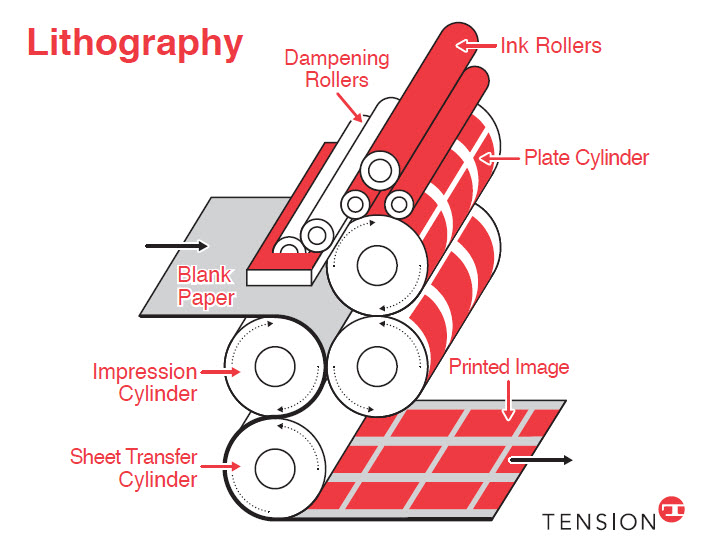Unique Designs Enhanced Through litho printing
Unique Designs Enhanced Through litho printing
Blog Article
A Comprehensive Overview to Comprehending Litho Printing Methods
The globe of litho printing, a technique originating from the late 18th century, is an interesting blend of background, art, scientific research and advancement. Remain with us as we trip into the exciting world of litho printing.
The Historic Advancement of Litho Printing
The historic trajectory of litho printing, a critical innovation in the realm of interaction, is a fascinating tale of human resourcefulness. The process developed with the development of the rotating press, which greatly increased efficiency. Each phase of litho printing's advancement showcases humankind's relentless quest of efficiency and high quality in aesthetic communication.
Decoding the Scientific Research Behind Litho Printing Inks
Relocating forward in the expedition of litho printing techniques, the emphasis currently moves to the science behind litho printing inks. The structure of these inks, their drying out process, and color mixing techniques form the backbone of this intricate art form. Recognizing these elements is important to mastering the craft and attaining the preferred print outcomes.
Structure of Litho Inks
In lithographic printing, the fundamental role of litho inks can not be overemphasized. The structure of litho inks varies depending upon its objective, however usually, they consist of 2 major components - pigments and vehicles. Pigments, the color-providing elements, are carefully ground bits put on hold in the vehicle, a liquid that lugs the pigment onto the printing surface area. The vehicle is a complicated mixture of solvents, oils, and resins, which affect the ink's drying out time, bond, and gloss. Additionally, different ingredients exist to enhance certain residential properties like flow, drying, and resistance to environmental impacts. Each part plays an essential component in the last print's high quality, making the exact formulation of litho inks an intricate science.
Ink Drying Process
From the composition of litho inks, focus turns to the interesting process of ink drying. The drying out procedure is essential, as it affects the last print's top quality and longevity. 2 primary methods are utilized in litho printing: oxidative drying and absorption. Oxidative drying out involves the ink reacting with oxygen in the air to form a difficult, completely dry film. This technique provides a sturdy finish, but can be slower contrasted to absorption. Absorption, on the various other hand, entails the ink leaking into the paper fibers, which is a faster procedure yet can cause less lively shades. The choice between these approaches is dependent upon variables such as print rate needs, the paper kind used, and the desired coating.
Shade Mixing Strategies
While the drying out procedure plays an essential duty in litho printing, the scientific research of shade mixing strategies holds equivalent importance. This is an intricate procedure that includes the cautious mixing of primaries: cyan, magenta, and yellow, in varying proportions to achieve a wide variety of colors. The enhancement of black ink, recognized as 'vital', helps in regulating the intensity and deepness of the shades. The scientific research behind litho printing inks additionally takes right into account the openness of the ink, which affects just how shades overlay and mix. To attain an effective shade mix, print experts have to also comprehend the intricacies of ink behavior, color theory, and the physical properties of the substratum on which the ink is applied.
The Art and Style Components in Litho Printing
Litho printing breathes life right into art and style with its one-of-a-kind elements. Litho printing accommodates a range of colors, allowing musicians to develop vibrant and dynamic prints. This combination of precision and flexibility makes litho printing a recommended option for many musicians and designers.
Modern Applications of Litho Printing Methods
Litho printing techniques have actually discovered extensive usage in the contemporary commercial market. Its impact and relevance continue to expand with the advent of new innovations and modern technologies in the area. This area will check out these contemporary applications and the transformative duty they play in the printing market.
Business Litho Printing Makes Use Of
Litho printing stays a vital component of the business industry. High-volume printing jobs, such as the production of publications, newspapers, and packaging, depend on litho printing for its capacity to supply exceptional photo quality and price performance. Litho printing likewise offers a wide color range, superior webpage to that of electronic printing.
Advancements in Litho Printing
Pressing the read here limits of standard techniques, contemporary advancements have fueled a host of advancements in litho printing. One popular development is electronic litho printing, which incorporates the merits of electronic modern technology with litho's top notch output. These innovations underscore the long-lasting relevance of litho printing in the contemporary globe.
Exploring the Refine of Litho Printing: Detailed

Obstacles and Solutions in Contemporary Litho Printing

In spite of the accuracy and tradition that litho printing proudly promotes, it is not without its set of contemporary difficulties. One of the most prevalent problems consist of the high initial setup expense, difficulty in printing variable information, and environmental concerns because of chemical use. Remedies are arising as innovation develops. Digital litho printing permits for cost-effective brief runs and very easy modification, addressing the problem of variable data. Environmentally-friendly inks and much safer plate-making processes mitigate ecological issues. Furthermore, improvements in automation have actually reduced labor expenses, even more equalizing the lithography procedure. Therefore, while there are obstacles, the litho printing industry is proactively adjusting to fulfill them head-on, guaranteeing its relevance in the future.
Verdict
In final thought, litho printing, with its rich background and scientific details, holds a significant place in the print sector. The future of litho printing hinges on its capability to adapt useful site to these transforming needs, affirming its enduring worth in a developing market.

Report this page